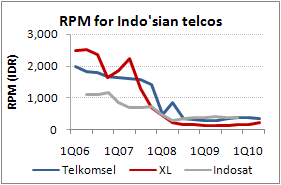New Telco’s Looking For A Way Out Of India’s Telecom Mess: Report
How New Telco’s Have Performed
The following telecom operators were given spectrum in January 2008, and below is the data for the quarter ending June 30th 2010:
- Datacom/Videocon: 1,942,364 subscribers
- MTS / Shyam Sistema: Gross revenue 109.09 crore for April-June 2010 quarter. 5,102,876 subscribers
- Etisalat DB / Swan Telecom: Rs. 0.18 crore gross revenue for April-June 2010 quarter. 18,196 subscribers
- Uninor/Unitech: Rs. 64.07 crore cross revenue for April-June 2010 quarter. 6,023,655 subscribers
- S Tel: Rs. 11.81 crore gross revenue for April-June 2010 quarter. 1,326,506 subscribers
Apart from these, Loop Telecom, Tata Teleservices, Allianz Infratech, Idea Cellular and Spice Communications were allocated spectrum. Of this group, Allianz Infratech was sold to Etisalat DB.
Loop Telecom reported gross revenues of 165.50 crores in Mumbai Circle, for the quarter ending June 30th 2010, and 2,926,797 subscribers. Loop had announced the launch of services beyond Mumbai, to Tamil Nadu and Orissa, but is it even there? According to the gross revenue reporting to TRAI for April-June 2010, Loop has reported revenues only for the Mumbai circle. Apart from STel, none of the new telcos were allocated 3G spectrum.
Of the the telecom operators which received spectrum in 2008, Etisalat, S Tel, Videocon and Loop appear to be struggling for a rollout. There were also rumors of Etisalat planning to buy stake in RCOM, and exiting the Swan venture.
Telecom Merger & Acquisitions Terms & Conditions
Recently, the Sachin Pilot, the Minister of State for Communications & IT clarified to the Parliament that the government had prescribed the following in the Guidelines (dated 22.04.2008) for intra service area merger of licences:
- Merger: Any permission for merger shall be accorded only after completion of 3 years from the effective date of the licences.
- Cross Holding: No single company/ legal person, either directly or through its associates, shall have an equity of 10% or more in more than one licensee Company in the same service area for the Access Services (Basic, Cellular and Unified Access Service).
- Lock In: there shall be a Lock-in-period for sale of equity of a person whose share capital is 10% or more in the UAS licensee company, till completion of three years from the effective date of the UAS licence, or till fulfillment of all the rollout obligations.
However, issue of additional equity share capital by way of private placement or public issues is permitted, as long as the person on whom the lock-in applies doesn’t transfer share capital directory or indirectly during the lock-in period. In case of issue of fresh equity, within the lock-in period the declaration of dividend and/or special dividend shall be barred.
Our Take
We’re currently in a situation wherein those with subscribers are starved for spectrum, and many of those without subscribers don’t appear to have the wherewithal to acquire and/or retain subscribers and actually utilize the spectrum. It’s a mess, and it was created by an opaque and allegedly corrupt spectrum allocation process, that also withheld available spectrum from incumbent telecom operators who needed it to service existing customers.
At the same time, all the companies that bought these licenses knew their risks, and if they were ready for the upside, they should have been prepared for the downside too. The Indian government should not offer them a refund, or give them a bailout. In our view, no M&A should be permitted until the three years are over, and if these companies do not meet their rollout obligations, then the government should take back the spectrum.
But one need not wait for three years for a way out of this artificial spectrum scarcity: if no M&A is allowed, at least licensees should be allowed to lease out spectrum to other licensees.







 Ganesh Duvvuri, telecom analyst, Edelweiss Securities, in an interview with Sunaina Vasudev, reviews the quarterly results of the telecom companies. Edited excerpts:
Ganesh Duvvuri, telecom analyst, Edelweiss Securities, in an interview with Sunaina Vasudev, reviews the quarterly results of the telecom companies. Edited excerpts:




